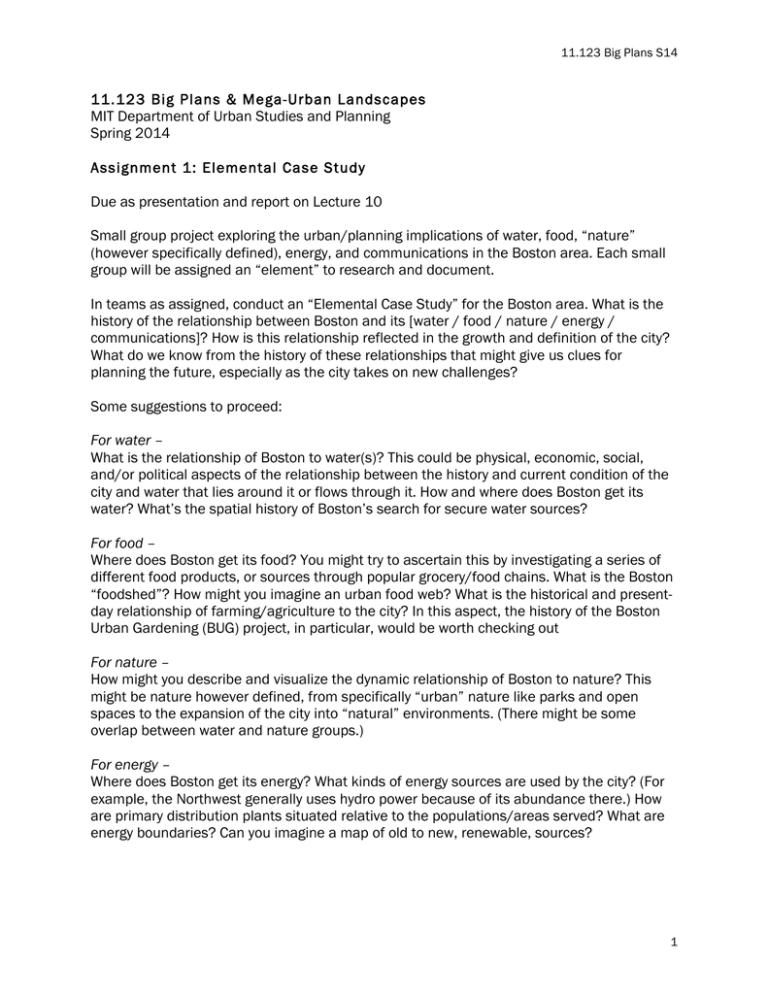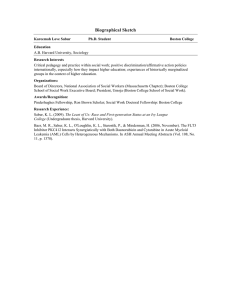11.123 Big Pla ns & M eg a -Urban Landscape... MIT Department of Urban Studies and Planning Spring 2014
advertisement

11.123 Big Plans S14 11.123 Big Pla ns & M eg a -Urban Landscape s MIT Department of Urban Studies and Planning Spring 2014 Assi g nment 1 : Elemental C ase S tudy Due as presentation and report on Lecture 10 Small group project exploring the urban/planning implications of water, food, “nature” (however specifically defined), energy, and communications in the Boston area. Each small group will be assigned an “element” to research and document. In teams as assigned, conduct an “Elemental Case Study” for the Boston area. What is the history of the relationship between Boston and its [water / food / nature / energy / communications]? How is this relationship reflected in the growth and definition of the city? What do we know from the history of these relationships that might give us clues for planning the future, especially as the city takes on new challenges? Some suggestions to proceed: For water – What is the relationship of Boston to water(s)? This could be physical, economic, social, and/or political aspects of the relationship between the history and current condition of the city and water that lies around it or flows through it. How and where does Boston get its water? What’s the spatial history of Boston’s search for secure water sources? For food – Where does Boston get its food? You might try to ascertain this by investigating a series of different food products, or sources through popular grocery/food chains. What is the Boston “foodshed”? How might you imagine an urban food web? What is the historical and presentday relationship of farming/agriculture to the city? In this aspect, the history of the Boston Urban Gardening (BUG) project, in particular, would be worth checking out For nature – How might you describe and visualize the dynamic relationship of Boston to nature? This might be nature however defined, from specifically “urban” nature like parks and open spaces to the expansion of the city into “natural” environments. (There might be some overlap between water and nature groups.) For energy – Where does Boston get its energy? What kinds of energy sources are used by the city? (For example, the Northwest generally uses hydro power because of its abundance there.) How are primary distribution plants situated relative to the populations/areas served? What are energy boundaries? Can you imagine a map of old to new, renewable, sources? 1 11.123 Big Plans S14 For communications – Communications is broad, and encompasses communications networks like telephone, cable, wireless, but also physical communication as in transportation networks. What is a map of Boston cell towers and coverage? What is the historical relationship of Boston to its transportation networks (waterways, roads, streetcars, highways, subways…)? For thi s project i t i s less i mp ortant to do an exhausti v e rep ort of all asp ects of y our el em en t, b ut m ore on e focused, coh esi v e story of on e or tw o factors of y our el em en t. Your team is curating, in effect, the story of the city and the [ ]. The idea of “sheds” might be useful – watershed, of course, but also “foodshed” or “commutershed.” In the same light, think about boundaries/borders, or gradients. De li ve rable s 10 mi nu te small gro u p pre se ntati o n , with up to 6 slides 6 page wr it t e n r e po r t , structured as follows ⋅ 1 sheet in t r o d u c t io n , general terms how element has impacted and transformed the city OR been impacted and transformed by the city ⋅ 1 sheet hi sto ry , discussing social, political, economic context in which large-scale changes to the element in question occurs in Boston ⋅ 1 sheet spati al -en v i ron m en tal tran sform ati on , illustrating the physical changes wrought in relation to the element ⋅ 1 sheet visu al representation of complete system showing what you found * ⋅ 1 sheet visu al depicting a det ai l or specific moment in the story * ⋅ 1 sheet on the future, showing future implications your study (threats, opportunities) *At least 2 v i sual rep resentati ons, one a “complete” representation of your element in the city, another a detail, diagram, or alternate view that explains a specific part of the story. 8 ½ x 11 s ize d , ho ri zo ntal or v erti cal format, font to be 10-11 point Arial, singlespace, ¾” margins all around. Note: planning reports are often done in landscape/horizontal format in order to accommodate plan documents and photos that are landscape in orientation. However, the ultimate format will be up to your team. A Boston “city-level” base map and aerial will be provided for your use. 2



